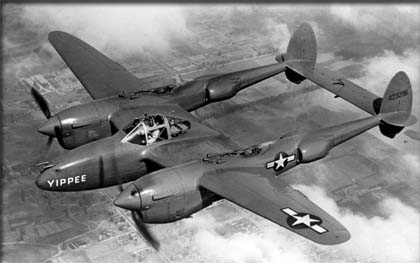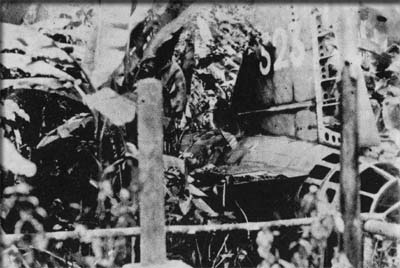pop up description layer
HOME
Cryptozoology UFO Mysteries Aviation Space & Time Dinosaurs Geology Archaeology Exploration 7 Wonders Surprising Science Troubled History Library Laboratory Attic Theater Store Index/Site Map Cyclorama
Search the Site: |
|
Operation Vengeance: The Mission to Kill the Architect of the Pearl Harbor Attack.
On April 18, 1943, 18 P-38 Lightning fighters
took off to intercept a plane carrying Admiral Isoroku Yamamoto.
Two years earlier, the Admiral's plan to cripple the U.S. Navy
at Pearl Harbor had killed 2,403 Americans and wounded 1,178
more. Now it was time to take revenge. It was an emotionally
satisfying move, but was it a wise one?
"Yesterday, December 7th, 1941- a date which will live in infamy - the United States of America was suddenly and deliberately attacked by naval and air forces of the Empire of Japan," declared President Franklin Roosevelt as the United States entered World War II. The attack, while the country was still officially at peace with Japan, had shocked and enraged the nation. In addition to the thousands of people killed and wounded, the nation had lost twelve warships, either beached or outright sunk, and nine others had been damaged. In addition, 160 aircraft were destroyed and another 150 impaired. The public wanted someone to blame and the logical person was the man who conceived the plan for the attack, Admiral Yamamoto. Isoroku Yamamoto Marshal Admiral Isoroku Yamamoto was born on April 4, 1884. Graduating from the Imperial Japanese Naval Academy in 1904, he served aboard a cruiser during the Russo-Japanese War. After the war, he traveled to the United States and studied at Harvard for two years, during which time he learned English. Reading several biographies of Lincoln, he became a great admirer of the President as a man born into moderate circumstances who later became a "champion" of "human freedom." He was later assigned as a naval attaché in Washington from 1926 to 1928. During this period, he travelled across the country observing such diverse sights as the automobile factories and oil fields. When he returned to Japan in the 1930's, he was decidedly against the aggressive warmongering policies of the Japanese Army. Knowing this would eventually bring the country into conflict with the United States, he feared an eventual Japanese defeat at the hands of America, which he realized had an enormous manufacturing capacity. "Anyone who has seen the auto factories in Detroit and the oil fields in Texas," he would later remark, "knows that Japan lacks the national power for a naval race with America."
This made him unpopular with the ultranationalist right and he often found himself the target of death threats. When Japan signed the Tripartite Pact with Germany and Italy in Berlin in September, 1940, however, Yamamoto, now the Commander-in-Chief of the Japanese Combined Fleet, realized that war with the United States was inevitable. Given this, he started to conceive a plan that would give his country the best chance of effectively winning the war on the first day by striking a massive blow to the America Pacific Fleet which was moored in Hawaii at Pearl Harbor. Even if the plan was successful, however, Yamamoto always doubted that Japan would win in the end. "In the first six to twelve months of a war with the United States and Great Britain, I will run wild and win victory upon victory. But then, if the war continues after that, I have no expectation of success," he admitted. With his knowledge of the American people, Yamamoto realized they would never give up short of total defeat, something he knew was impossible for Japan to achieve. "Should hostilities once break out between Japan and the United States, it is not enough that we take Guam and the Philippines, nor even Hawaii and San Francisco. To make victory certain, we would have to march into Washington and dictate the terms of peace in the White House." Despite Yamamoto's reservations, Japan started the war and this quote was later twisted by the Japanese propaganda machine to suggest that Yamamoto expected that he would be able to dictate surrender terms in the White House, just the opposite of what he meant. The misquote further raised American anger at the Admiral and the desire for vengeance against him. By 1943, much of what Yamamoto had predicted had come true; he was extremely successful for the first half year of the war, but suffered a stunning defeat in June of 1942 at the Battle of Midway when all four of Japan's large aircraft carriers were sunk, turning the tide of the conflict. Yamamoto was still popular with his men and to raise morale, he planned an inspection tour of many of the front line bases. His subordinates were anxious that such a move might expose him to attack, but the Admiral insisted. As it was, his people had good reason to be concerned. Cryptanalysis "Magic" Since before the beginning of the war, American Intelligence had been breaking and reading Japanese encrypted communications. While this had not averted the disaster at Pearl Harbor, the project, code named "Magic," had given the Americans the advantage at Midway, allowing them to score an important victory. Now it gave them Admiral Yamamoto's itinerary for the inspection tour, including the types and number of aircraft escorting him. The question was whether the Americans should use this information to extract revenge. As satisfying as such a move would be, there were reasonable arguments against it, the most important being the continuing security of the Magic project. A squadron of American fighter planes flying hundreds of miles from their base to intercept Yamamoto's tour would suggest a deep, inside knowledge of Japanese operations and the possibility that the Americans were reading their communications. If the Japanese came to this conclusion, they might decide to make radical changes to their codes, causing the United States to lose this valuable intelligence. This would invariably translate into lost American lives. Still, the desire for vengeance outweighed caution. There were rumors that the order came down from the top and that President Roosevelt himself may have commanded the navy to "Get Yamamoto!" In any case, on April 18, 1943, the squadron left Kukum Field in the Solomon Islands to intercept Yamamoto's flight near Bougainville.
To avoid being detected on radar, it was determined that the planes would need to take a roundabout route flying at wave top levels some 600 miles, then after the attack return directly to their base, another 400 miles. Only one U.S. fighter in the area had the kind of range necessary to carry out this 1,000 mile mission: The P-38G "Lightning." Lightning Strike The Lightning was an odd-looking aircraft. Unlike most WWII fighters, it had twin engines which extended back to two separate tails. In the center of the wings was a pod for the pilot, guns and ammo. The squadron of 18 Lightning fighters were divided into two groups: Four would be the "Killers," who would actually make the attack, and the rest would handle any fighters that would rise to defend the flight. The flight also included two extra aircraft to take the place of any forced to turn back early in the mission because of mechanical problems. This was good planning as just that number never made it to the interception, but needed to return to base for maintenance. The timing of the attack was almost perfect with the Lightnings arriving at the interception point just one minute before Yamamoto's tour came into view. The Admiral's flight consisted of two Mitsubishi "Betty" Bombers (the Admiral riding in one of them) escorted by six Mitsubishi A6M Zero fighters. Though accounts differ, historians believe that Lt. Rex T. Barber struck the fatal blow coming up from behind Yamamoto's aircraft and firing into its left engine until the plane went out of control and crashed into the jungle below, while his wingman, Capt. Thomas G. Lanphier, attacked the defending Zeros. Afterward Barber, not knowing which plane carried the Admiral, turned his attention to the second bomber which was trying to escape. It had been attacked by Lt. Besby F. Holmes and his wingman, Lt. Raymond K. Hine. Holmes had managed to damage the bomber's right engine, but then overshot the target before he could finish it off. Barber came in to complete the kill, with the bomber making a crash landing in the ocean. Holmes, Hine and Barber then came under attack by the enraged Zero escorts. Holmes and Barber escaped, but Hine's plane was shot down, killing him. As the victorious flight returned to Kukum Field, Lanphier radioed the fighter director "That son of a bitch will not be dictating any peace terms in the White House!" This was a huge breach of security. The cover story for the mission was that an Australian coastwatcher had spotted an important high-ranking Japanese naval officer boarding an aircraft, and that the mission had been launched on this information. There was no way, however, such a coastwatcher could have known the identity of the high-ranking officer, so Lanphier's outburst, if picked up by the Japanese, would have suggested a breach in the Japanese's encrypted communications.
Fortunately, the Japanese never made the connection. A few days later, a search and rescue party found the body of Yamamoto still strapped to his seat of the "Betty" that had crashed in the jungle. He had been killed by one of the Lightning's rounds which had passed through his head. The Japanese hid his death from the public for over a month before announcing it on May 21, 1943. One wonders, though, if the satisfaction of vengeance on Yamamoto was worth risking the "Magic" codebreaking project. In addition, Yamamoto was an opponent of the war before hostilities broke out. Perhaps he would have been a voice of reason as the war came to its conclusion. Could his influence have brought the conflict to a quicker end and saved perhaps thousands of American and Japanese lives? We will never know. Copyright 2018, Lee Krystek. All Rights Reserved. |
|
Related Links |
|
|







